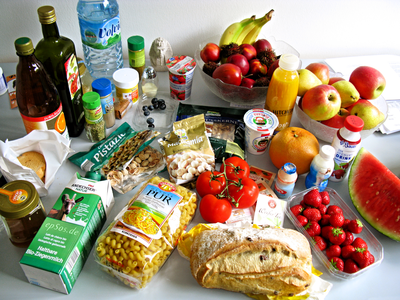Healthy eating habits/Healthy Eating with the Australian Guide to Healthy Eating 2013

The Australian Dietary Guidelines Simplified
[edit | edit source]The new Australian Guide to Healthy Eating was released this year (2013) and there are five major recommendations:
- Achieve and maintain a healthy weight, be physically active, and choose nutritious foods to meet your energy needs;
- Enjoy a wide range of nutritious foods from the five food groups;
- Limit foods high in saturated fat, salt, sugar and alcohol;
- Encourage and support breastfeeding;
- Follow food safety recommendations.
This simplified tool focuses on the first two recommendations and is aimed to help you meet the new Healthy Eating Guidelines for Australian adults.
How many serves should I be having?
[edit | edit source]
|
Recommended Number of Serves for Australian Adults
|
Healthy Eating and the 5 Food Groups
[edit | edit source]
|
Healthy Eating and the 5 food groups
Use the table below to fill in your recommended number of serves based on your age and gender and use the serving size references to help you with portion control. You can also use the Daily Tally column to monitor your own intake and achieve your optimum intake from the 5 food groups.
Sourced from [2] |
Where Can I Get More Information?
[edit | edit source]
You can find more information about healthy eating at the Australian Guide to Healthy Eating website.
References
[edit | edit source]- ↑ Food Standards Australia and New Zealand. (2010). NUTTAB 2010 Online Searchable Database. Retrieved from http://archive.foodstandards.gov.au/consumerinformation/nuttab2010/nuttab2010onlinesearchabledatabase/onlineversion_code.cfm?&action=default.
- ↑ [National Health and Medical Research Council. (2013). Australian Dietary Guidelines Summary. Retrieved 30 October, 2013, from https://www.eatforhealth.gov.au/sites/default/files/files/the_guidelines/n55a_australian_dietary_guidelines_summary_131014.pdf]
3. National Health and Medical Research Council. (2013). Australian Dietary Guidelines Summary. Retrieved 30 October, 2013, from https://www.eatforhealth.gov.au/sites/default/files/files/the_guidelines/n55a_australian_dietary_guidelines_summary_131014.pdf
4. National Health and Medical Research Council. (2013). Healthy Eating for Adults. Retrieved 30 October, 2013, from https://www.eatforhealth.gov.au/sites/default/files/files/the_guidelines/n55g_adult_brochure.pdf.
